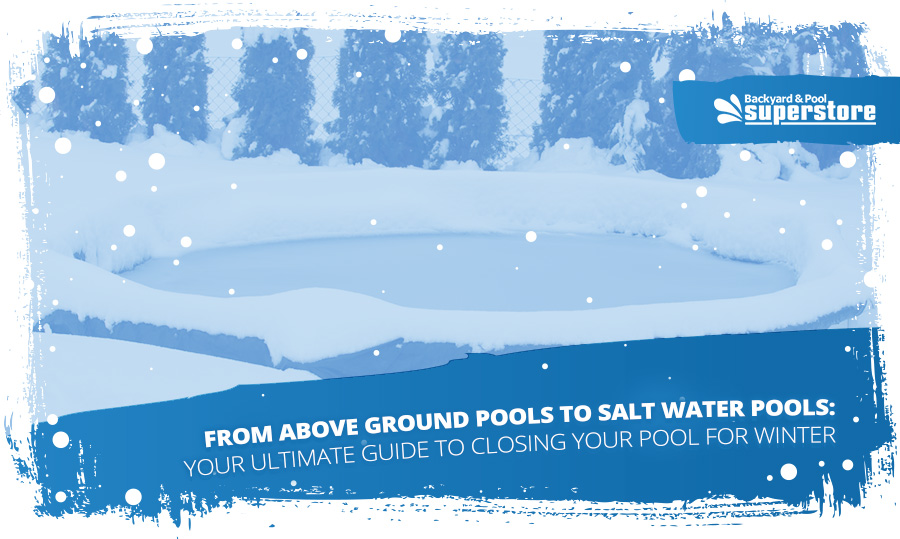
It’s that time of the year again. The leaves are changing, the temperature is dropping by the day, and pool season is coming to an end. If you’re like most pool owners, now is the time to close your pool for winter. If you make sure that your pool is ready for the coldest months of the year, you’ll open it back up again in the spring, delighted to see that your pool is still in great shape.
Simply strapping a cover on your pool before the start of winter isn’t enough to protect it over the next few months. You need to clean the pool, add winterizing chemicals, and, in some cases, lower the water level to make sure your pool doesn’t turn into a sludge pit come February.
However, every pool is different. We’ll walk you through the steps needed to close all kinds of backyard pools, including above-ground, in-ground, and saltwater pools. Whether you live in the north or the tropical south, learn how to protect your pool over the next few months so you don’t have to deal with a gunk-filled lagoon in the spring.
Knowing When to Close It Up: Warm Climate vs. Cold Climate
Finding the right time of year to close down your pool varies, based on where you live and the local climate. Typically, the temperature threshold is 65 degrees Fahrenheit. If the average temperature in your area falls below that number, it’s time to start closing down your pool. This usually occurs in late October and early November throughout the northern region of the U.S.
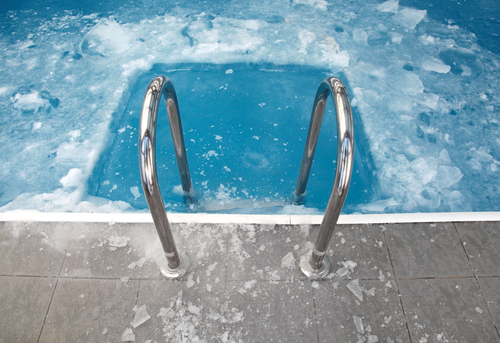
If you live in a more temperate climate, you might see a few days inch above 65 degrees Fahrenheit over the course of the winter. It’s still a good idea to close your pool at the start of winter, but you can use these warmer days to clean and test your pool.
If you live in the deep south where most days are above 65 degrees, you might not want to close your pool at all. States like Florida, New Mexico, and Texas are known for their warm winters, so you might want to keep your pool open just in case you want to take a dip. The same scenario applies to heated swimming pools, which will extend your pool season. When in doubt, ask yourself if you plan on using your pool over the next three months. If the answer is no, it’s time to close your pool.
Closing an Inground Pool for Winter
Let’s start with in-ground pools. These kinds of pools are more expensive than the above ground variety, so you need to do everything you can to protect your investment. If you rush through the winterization process, you’ll have a nasty mess to contend with in the spring. Some parts of the pool may even crack or become unsafe. While some of these steps will vary, based on the local climate, here’s everything you need to know to close your in-ground pool for winter.
1. Clean the Pool
Roll up your sleeves! It’s time to get to work. The winterization process all starts with a deep clean. Instead of letting your robot vacuum do the heavy lifting, grab a pool brush and attach it to a telescoping pole so you can reach every inch of your pool. Scrub all those hard-to-reach places. This should release some light debris into the water as you knock all that bacteria and sediment loose.
If you notice green or murky stains in your pool, you should also use an algae brush to clean the sides. This removes the algae or breaks up the spores before the algae can take root. Once you’ve knocked everything loose, it’s time to start vacuuming. It’s best to do the vacuuming manually, so you can soak up all that extra debris. Your pool should be spotless before you move on to the next step.
2. Test the Levels
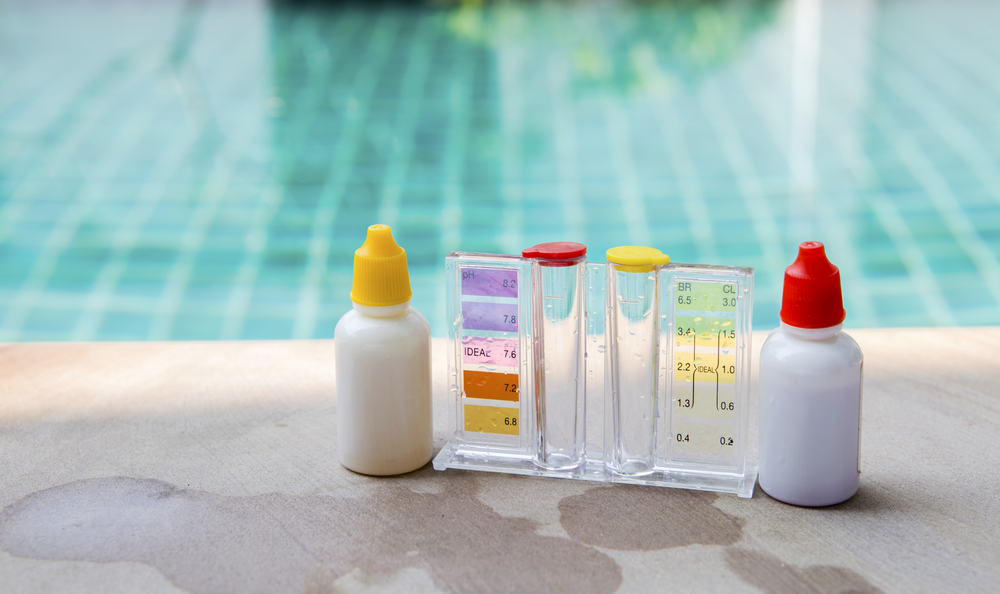
Now it’s time to test the pool water using a pool test kit. You need to make sure the water is properly balanced, including the pH levels, alkalinity, and other important minerals. Make sure the chlorine level is less than five parts per million and the alkalinity is between 100 and 150 parts per million. PH levels should be between 7.2 and 7.8. This protects the pool from rust and buildup over the winter months.
3. Add Special Chemicals for Winter
Once the water levels have been tested, you need to add special winterizing chemicals that protect the pool from turning into a algae pond. Let’s start with the basics:
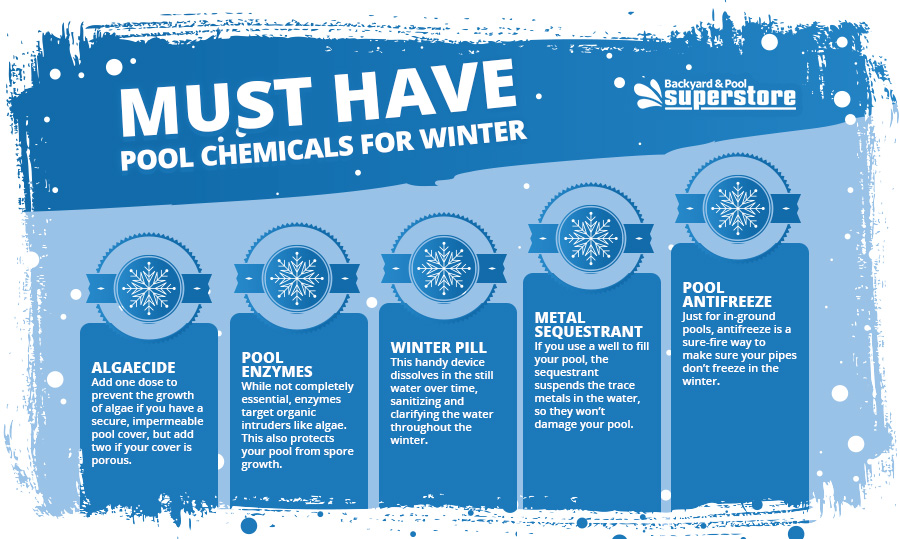
Algaecide: This product stops algae growth in its tracks. Add one dose to prevent the growth of algae if you have a secure, impermeable pool cover, but add two if your cover is porous.
Pool Enzymes: While not completely essential, enzymes target organic intruders like algae. This also protects your pool from spore growth instead of depending entirely on the algaecide to do its job.
Winter Pill: Your pool needs medication, too. Toss a WinterPill into the water before you shut down the pool. This handy device dissolves in the still water over time, sanitizing and clarifying the water throughout the winter.
Metal Sequestrant: If you use a well to fill your pool, there’s a good chance the water is filled with lots of trace metals. Without this chemical, the metals would stick the edges of your pool and cause them to rust, but the sequestrant suspends them in the water, so they won’t damage your pool.
Pool Antifreeze: Just for in-ground pools, antifreeze is a sure-fire way to make sure your pipes don’t freeze in the winter. You can try drying out these pipes, but there’s still a chance they could contain some trace amounts of moisture. Find antifreeze with a temperature rating that matches the local climate. It’s usually best to find some with a rating of 10 degrees Fahrenheit, but you may need to go lower if the temperature in your area tends to drop below zero. Make sure you grab pool antifreeze and not the automobile variety.
4. Shock Your Pool
Don’t forget to shock your pool one last time before putting it to rest for the season. This means adding chlorine tablets to kill any bacteria still floating around in the water. It’s best to complete this step at night and let the pump run until morning, so the chemicals circulate throughout the water.
For saltwater pools, you can also use a salt water cell to circulate the chlorine around the pool.
5. Lower Your Water Levels
Lowering the water level prevents overflow if the water freezes. If you live in a warm climate, don’t worry about lowering the water, considering the chances of your pool freezing over are slim to none.
Setting the water level depends on what kind of cover you’re using. For vinyl liners, bring the water down to one inch below the skimmer or tile line. For solid non-vinyl liners, bring it down to six inches below the skimmer or tile line. For mesh or permeable non-vinyl liners, bring it down to two feet below the skimmer or tile line.
When draining the water, make sure you pay attention to your community’s wastewater rules before dumping the excess water down the drain.
6. Clean the Filter
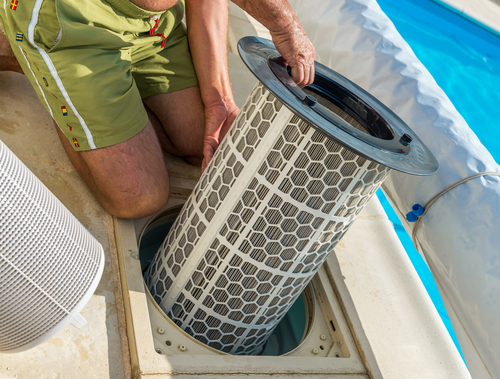
Your filter is probably filled with all kinds of nasty debris at this point. Remove it and wash it with some special pool filter cleaner before you close things down. This way, you’ll have a clean filter ready to go for spring.
7. Blow Out Your Lines
This step is best completed by a professional, as draining your pool lines can be tricky. If you miss something, your lines could burst as the temperature continues to drop. This isn’t necessary for those who live in warmer climates.
To get started, attach an air blower to the main drain and blow air through the pipes. Use a rubber plug to stop water from entering the system. Again, drying the system isn’t an exact science, so you may want to use pool antifreeze just to be safe.
8. Remove Pool Accessories
This step is an absolute must if you have a saltwater pool. All that extra salt can cause your pool accessories to rust. Take all ladders, toys, rails, and other add-ons out of the water, dry them, and store them inside for the winter.

9. Cover the Pool
Finally, cover the pool, including the pool pump. This protects your newly cleaned pool from the elements. Different types of winter pool covers may get bogged down with snow, leaves, and other debris over time, so make sure you keep it clean during the winter.
Closing an Above-Ground Pool for Winter
Now, let’s move on to above-ground pools. Many of these steps will be the same as those for in-ground pools, but some elements of the winterization process will change. Use these tips to keep your above-ground pool in great shape all winter long.
Clean Your Pool: Like with an in-ground pool, it’s important to be thorough.
Test the Waters: Again, shoot for pH levels between 7.2 and 7.8. Chlorine should be less than five parts per million, and alkalinity should be between 100 and 150 parts per million.
Add Winter Chemicals: Add the regular winter chemicals into the water, including algaecide and pool enzymes. If you noticed that some of your water levels are off, you may need to add some pH increaser, alkalinity increaser, or some calcium hardness increaser. Calcium hardness should be between 150 and 400 parts per million. If the water is too hard, it could damage the surrounding structure of your above-ground pool.
Shock the Pool: For above-ground pools, you can use a traditional pool shock that can take up to 24 hours to circulate throughout the water. If you prefer to speed up the process, you can use a fast-dissolving shock.
Protect Your Pool Lines: Your pipes may burst if they freeze during the winter. Dry out the lines with an air blower and seal them with an expansion plug. You can also use antifreeze as an added precaution. This step isn’t necessary for those who live in the south unless the temperature tends to dip below freezing.
Clean and Remove Pool Accessories: It’s usually best to remove the pool filter, pump, and skimmer for the winter, especially if you live up north where the weather can be bitterly cold. You can also use a skimmer plate if you’d rather leave the skimmer in the pool. Dry these items and store them safely for the winter. You should also remove any and all pool accessories, including ladders, toys, and railings.
Lower the Water Level: If you removed your skimmer, you should lower the water below the skimmer or tile line, but, if you leave your skimmer in place with a protective plate, you can leave the water as is. You don’t need to drain the water if you live in a warm climate.
Insert a Pool Pillow: If your pool cover gets buried in ice and snow, you should insert a pool pillow in the water. This inflatable device adds an extra layer of support, so your pool cover doesn’t sink too low. Don’t inflate the pillow all the way. Shoot for an inflation rate of 50 to 60%, so the pillow won’t pop under pressure. Place it in the center of the pool.
Cover the Pool: Finally, cover the pool while keeping the pool pillow as centered as possible. It may slip out of place, but you don’t want it touching the sides all winter long.
That’s it! You’re all done. Your above-ground or in-ground pool is all set for a few months of cold weather. If you don’t feel comfortable completing some of these steps yourself, you can always hire a professional. It’s better to be safe than sorry when getting your pool ready for winter. A small error could do a lot of damage to your investment over the next few months. Be thorough and protect your pool all year long.
 Hello Guest,
Hello Guest,  0 item(s)
0 item(s)
